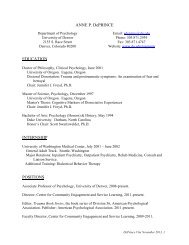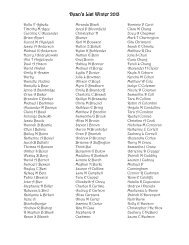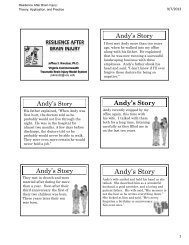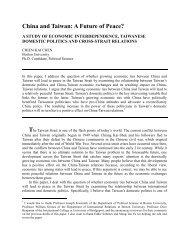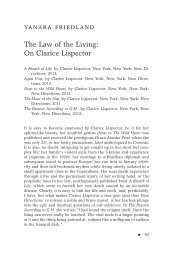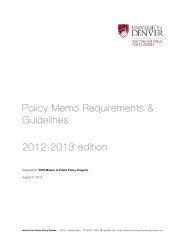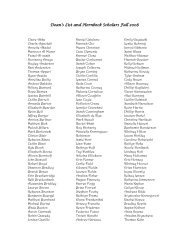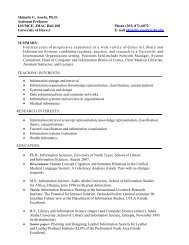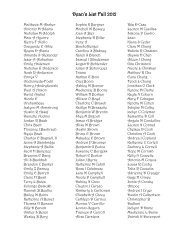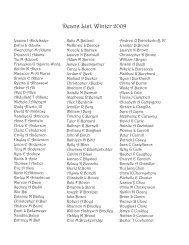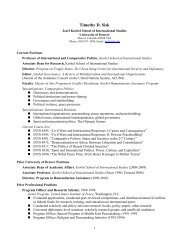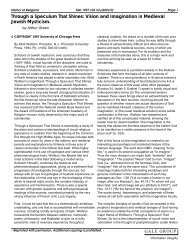You also want an ePaper? Increase the reach of your titles
YUMPU automatically turns print PDFs into web optimized ePapers that Google loves.
Where in theWorld is <strong>GSSW</strong>?<br />
Bosnia and HeRzegovina<br />
Fresh Figs and a<br />
New World View<br />
by Clinical Associate Pr<strong>of</strong>essor<br />
Ann Petrila, MSW, MPA<br />
Director <strong>of</strong> Field Education<br />
and Director <strong>of</strong> Project<br />
Bosnia and Herzegovina<br />
When a friend in Bosnia gave me<br />
a fresh fig, I wasn’t sure what it<br />
was. Was I supposed to peel it or cook it or just bite into this fruit<br />
that I had never seen before? Something wonderful wrapped in an<br />
unfamiliar package—it is not only figs that fit this description in<br />
Bosnia and Herzegovina (known as Bosnia or BiH). This is a country<br />
with a confusing name, an even more perplexing government<br />
structure, natural beauty, strong and humble people, and a history<br />
both rich and horrifying.<br />
Serendipity took me to BiH the first time in 2007, when I provided<br />
supervision and agency development for <strong>GSSW</strong> students interning<br />
with Project Bosnia, DU’s oldest international service learning<br />
program. What I assumed would be a one-time visit was the start<br />
<strong>of</strong> opportunities that I never thought possible. In 2011, I was<br />
named Director <strong>of</strong> Project Bosnia and also taught <strong>GSSW</strong>’s first<br />
MSW course on social work in Bosnia.<br />
On that first trip to Sarajevo, I had no idea what to expect. What<br />
would a capital city in Eastern Europe look like? I discovered a<br />
welcoming, secular city where churches and mosques sit side-by-<br />
side, where the ancient call to prayer rings out five times a day<br />
and where peace-keeping forces are noticeable everywhere. Most<br />
striking was the beauty <strong>of</strong> the city and countryside, although<br />
noticeably blemished by the ravages <strong>of</strong> war.<br />
I quickly learned about Bosnian hospitality, about the importance<br />
<strong>of</strong> meeting over Bosnian c<strong>of</strong>fee, and about the resilience <strong>of</strong> people<br />
who were targeted for genocide and lived under siege for three<br />
years in the1990s. The Bosnian sense <strong>of</strong> humor delighted me from<br />
the very beginning.<br />
Since that first trip in 2007, I have facilitated a formal affiliation<br />
agreement between <strong>GSSW</strong> and the <strong>University</strong> <strong>of</strong> Sarajevo School<br />
<strong>of</strong> Social Work that has led to a partnership with my Bosnian<br />
colleague and friend, Pr<strong>of</strong>essor Sanela Sadic. As a visiting lecturer<br />
at the <strong>University</strong> <strong>of</strong> Sarajevo, I taught classes to Bosnian social<br />
work students. In turn, Sanela traveled to the U. S. when she was<br />
awarded a Kendall Fellowship through the Council on Social Work<br />
Education. Our shared projects continue to grow.<br />
For the first time in 2011, <strong>GSSW</strong> students had the opportunity<br />
to take an MSW course I developed entitled “The Social Work<br />
Response in Post-War Bosnia.” The students learned about Bosnian<br />
history, culture, religion and politics, then spent two weeks in<br />
Bosnia where, paired with Bosnian social work students, they<br />
visited historically significant sites and social work agencies. The<br />
students also attended lectures by <strong>University</strong> <strong>of</strong> Sarajevo faculty.<br />
Our group stayed in old town Sarajevo—Baščaršija—and, by the<br />
end <strong>of</strong> the trip, students could even pronounce it! I watched our<br />
students fall in love with the beauty and people <strong>of</strong> BiH, even as<br />
they struggled with the reality that genocide took place here in the<br />
1990s while the world looked on. I saw our students realize how<br />
much they had in common with their new Bosnian friends, while<br />
also understanding that the Bosnians had experienced things<br />
Americans can’t begin to imagine. Through their interactions with<br />
the resilient Bosnian people, our students began to shift their<br />
world view and challenge some <strong>of</strong> their long-held beliefs in ways<br />
that happen only through international experiences like these.<br />
In addition to teaching the MSW class, I also take Project Bosnia<br />
students from across the <strong>University</strong> <strong>of</strong> <strong>Denver</strong> campus to Sarajevo<br />
each summer. For eight weeks, these students immerse themselves<br />
in Bosnian culture by completing internships in organizations<br />
focused on reconciliation, peace and the healing <strong>of</strong> people still<br />
scarred by the war. These students arrive in BiH expecting to be<br />
productive “American-style,” but they soon realize the rewards<br />
<strong>of</strong> working in a country where relationships are developed and<br />
maintained over c<strong>of</strong>fee.<br />
My hope is to introduce many more students to Bosnia, once as<br />
mysterious to me as that fresh fig, now a place I’ve come to know<br />
and love. When people ask me why I go there, I can’t help but<br />
think, why wouldn’t you go to Bosnia?<br />
Through the Glass: A Reflection on<br />
Project Bosnia and Herzegovina<br />
by Kristi Roybal, concentration year MSW student<br />
It’s been more than six months since I returned to the United<br />
States from my Project Bosnia experience. But as I write this in<br />
the space I call home, images <strong>of</strong> Bosnia surround me. Every time<br />
I walk in the door or read with a cup <strong>of</strong> c<strong>of</strong>fee, I see three <strong>of</strong><br />
the most evocative images—the keepers <strong>of</strong> moments frozen in<br />
time that tell only part <strong>of</strong> a story.<br />
I see a life-size chess figure, its paint peeling from years <strong>of</strong><br />
weathering, waiting to be played by chess players strategizing<br />
their next move. Beneath that, a sea <strong>of</strong><br />
aged pocket watches, no longer ticking like<br />
they used to, but stopped at some moment<br />
in time that was likely meaningful for<br />
someone else. And the face <strong>of</strong> a Bosnian<br />
woman, Rahima, her beautiful headscarf,<br />
perfectly rendered wrinkles, a purposeful<br />
gaze surveying the Bosnian mountainside or<br />
perhaps the strangers visiting her village.<br />
Images have always been a powerful<br />
influence in my life, obliging me to reflect<br />
upon the power I carry as a photographer, the biases<br />
and perspective I bring to composition, the ethics<br />
and meaning <strong>of</strong> “seeing.” But it’s also an important<br />
metaphor in my life as a student, a social worker, a<br />
traveler, a participant in the humdrum <strong>of</strong> everyday<br />
life. I will always look through the metaphorical<br />
glass—through the bus windows, through the complex<br />
layers <strong>of</strong> knowledge gained from life, books and an<br />
unrestrained imagination, through the lens <strong>of</strong> my own<br />
existence. While I’ll never fully understand the whole<br />
story that belongs to some other person or place, I<br />
find deep meaning in the fragments <strong>of</strong> knowledge I<br />
allow myself to perceive and reflect upon. I find deep<br />
meaning in the awareness that my “seeing” is caught<br />
up in the very existence <strong>of</strong> someone or<br />
something else.<br />
As I reflect upon the Bosnian chess<br />
players, the broken down pocket<br />
watches and a woman’s gaze locked<br />
in my time, I see the inevitability <strong>of</strong><br />
only understanding myself through<br />
attempting to understand everyone and<br />
everything else around me. Regardless<br />
<strong>of</strong> how long I’ve been back or gone, the<br />
subtleties <strong>of</strong> daily experiences—those<br />
from my time in Bosnia and those I will<br />
freshly live tomorrow—all converge to<br />
shape how I see in the world.<br />
Photo credit this page: Kristi Roybal<br />
Hundreds <strong>of</strong> traditional<br />
Moslem grave markers on<br />
a Sarajevo hillside provide<br />
a stark reminder <strong>of</strong> the<br />
ethnic cleansing campaign<br />
that occurred during the<br />
1992–1995 Bosnian War.<br />
8 spring 12 where in the world is <strong>GSSW</strong>? where in the world is <strong>GSSW</strong>? spring 12 9



